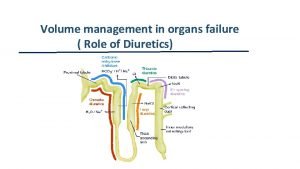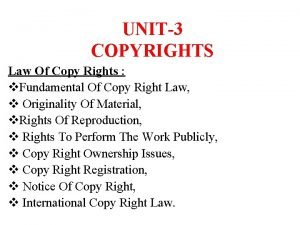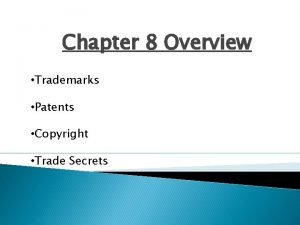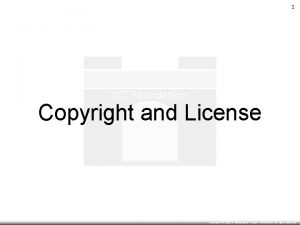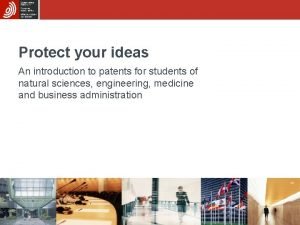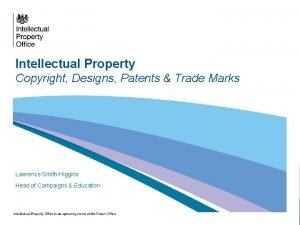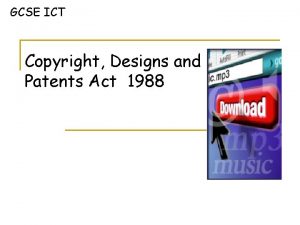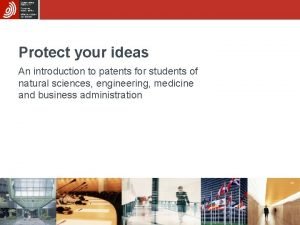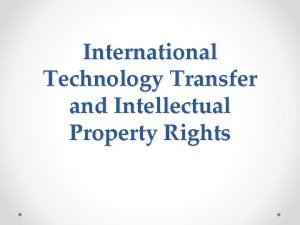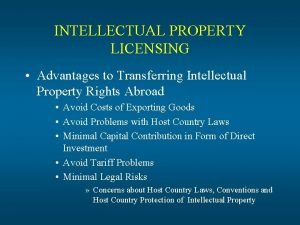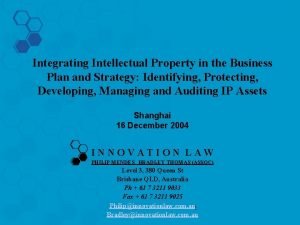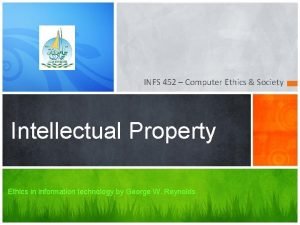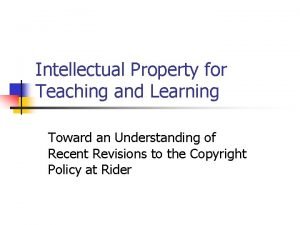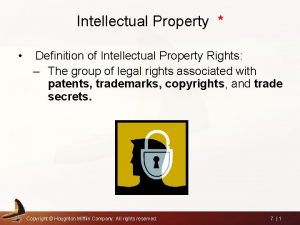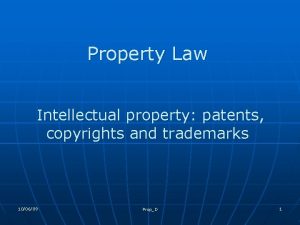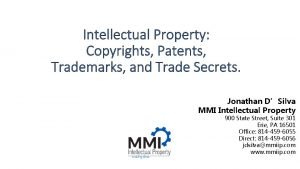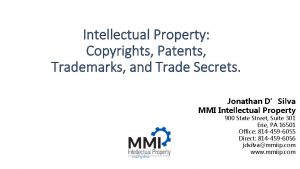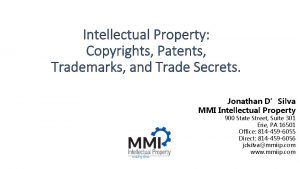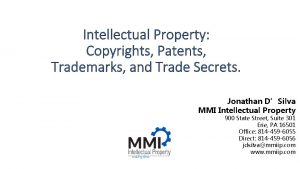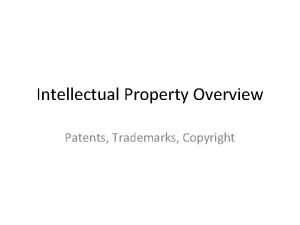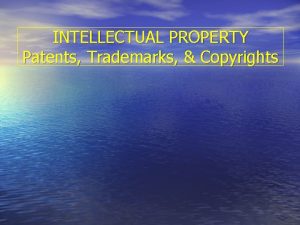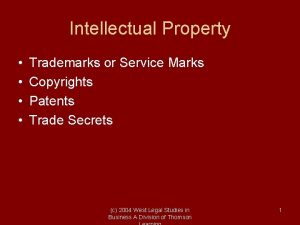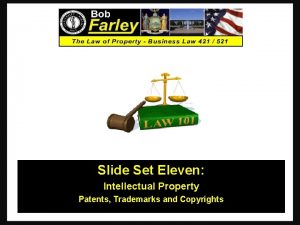Class Seven Intellectual Property Patents Trademarks and Copyrights

















- Slides: 17

Class Seven: Intellectual Property Patents, Trademarks and Copyrights

Last Class – We Spoke About: • Part One: A Brief Review • Part Two: A Continuation of Rights, Ownership, Possession and Transfers – Including: - Liens, - Bailments and - Special Interests.

Tonight’s Class: • We will discuss Intellectual Property Concepts - Patents - Trademarks and - Copyrights; and

Intellectual Property • Not all property is tangible This is why we need to think of property in terms of “rights” not “things”. • This concept becomes especially important for intellectual property.

Intellectual Property Although common law was reluctant to invest property rights in an “idea”, modern society and law have evolved property rights to include certain unique intellectual designs, processes or works. Although most property law is state law, virtually all intellectual property law is based upon federal statutes.

Intellectual Property It all starts with an idea!

Intellectual Property Copyrights – Rights in Writings, Art or Expression Defined as “Original works of authorship fixed in any tangible medium of expression”. Key Elements 1. Originality (Uniqueness) 2. Work of Authorship (Literary, music, dramatic, graphic, movies, audio and Architectural) *Software is viewed as literary 3. Fixation (Any physical rendering)

Intellectual Property Copyrights Bundle of Rights – Including the right to: • • Prevent Reproduction Create derivative works Distribute Copies Perform, display or transmit the Work Publicly Duration of Rights: • • • If created after 1978 - Life of the author plus 70 years (No renewal) If created before 1978 – 28 years plus a renewal for 47 years (75 years) Work for Hire Exception – 95 years from publication or 120 from creation whichever is less.

Intellectual Property Copyrights To prove Infringement – A Plaintiff Must: 1. Hold a valid copyright 2. The defendant copied the work; and 3. The copy was inappropriate appropriation (Two works are substantially similar) Defenses: Agreement or Fair Use – Protecting the Copyright and protecting the minimal use and free speech rights of the user. Remedies: Injunction, Impoundment and Destruction, and Damages

Intellectual Property Patents The intellectual property rights vested in anyone who “invents or discovers any new or useful process, machine, manufacture, or any composition of matter, or any new or useful improvement thereof. ” Four Elements: 1. Patentable subject matter 2. Utility 3. Novelty; and 4. Non-obviousness

Intellectual Property Patents 1. Patentable Subject Matter a. Process b. Machine c. Manufacture, or d. Composition of Matter

Intellectual Property Patents 2. Utility The Invention must be useful and provide actual benefit 3. Novelty The Invention must new, novel and unique. 4. Non-obviousness The Invention must not be obvious to a person of ordinary skill in the subject area.

Intellectual Property Patents 1. Nature of Rights - The Right to prevent others from making, using or selling the invention. - A patent is federal right with no rights directly transferable outside the US. - Must file the patent in every nation in which they wish to protect. 2. Duration of Rights - 20 years from the date the patent is filed - Nonrenewable and require a maintenance fee to the PTO.

Intellectual Property Trademarks A trademark is any “word, name, symbol or devise used by a person to identify and distinguish their goods from those sold by others” Requirements: • Distinctiveness • Non-functionality • First use in trade Duration – Good for 10 years with infinite renewals

Registration and Recording US Patent and Trademark Office Washington DC Practice before it and the Federal Courts requires admission to a separate bar Can clerk at the office and don’t have to be a lawyer.

Modern Trends Concerns over China – Reverse Engineering Especially big issues with items uniquely Intellectual – music, software, processes Big players General Electric Disney Motion Picture Companies

• Bonus Questions of the Day For next time – Read Assignments for Class One to Seven • We have our Midterm October 18, 2012 • Questions? ? ?
 Image copyrights
Image copyrights Copyrights
Copyrights First sale doctrine copyright
First sale doctrine copyright Copyrights
Copyrights Copyrights
Copyrights Simproved harry potter world
Simproved harry potter world What is the copyright designs and patents act 1988
What is the copyright designs and patents act 1988 Design and patents act 1988
Design and patents act 1988 Advantages and disadvantages of patents
Advantages and disadvantages of patents Trade related aspects of intellectual property rights
Trade related aspects of intellectual property rights Secondary infringement
Secondary infringement Importance of intellectual property
Importance of intellectual property Intellectual property management definition
Intellectual property management definition Licensing advantages
Licensing advantages Intellectual property business plan example
Intellectual property business plan example Property
Property Right to intellectual property of teachers
Right to intellectual property of teachers Intellectual property law definition
Intellectual property law definition

